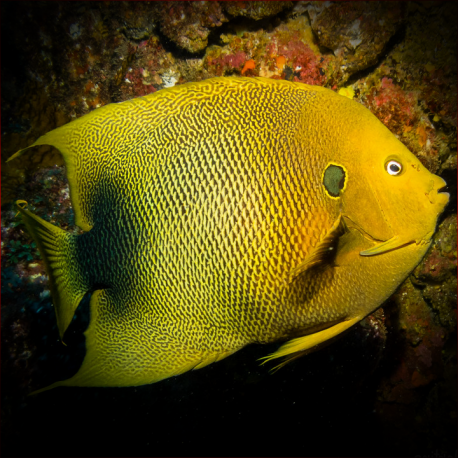More info
Datasheet
| Minimum Tank Size | 567 litres / 149.79 US gallons |
| Maximum Size | 15.2cm / 5.98inches |
| Reef Compatible | With Caution |
| Temperament | Semi-aggressive |
| Care Description | Moderate |
| Specific Gravity | 1.020-1.025 |
| Carbonate Hardness | 8-12 |
| pH | 8.1-8.4 |
General Description
The West African Angelfish, also known as the African Angelfish or Guinean Angelfish, displays a striking appearance. Juveniles boast a vibrant blue coloration with a yellow tail, which transitions as they grow. These fish can reach lengths exceeding a foot, showcasing hues of orange, yellow, and olive green as they mature.
Aquarium Suitability
The West African Angelfish is moderately suitable for aquariums. Given its potential size of over a foot, a minimum tank size of 150 gallons is recommended. It is a hardy species; however, its semi-aggressive nature calls for careful selection of tank mates to prevent conflicts.
Care and Hardiness
This species requires a balanced diet that includes marine algae, Spirulina, meaty foods, and high-quality angelfish preparations with sponge content, offered at least thrice daily. With appropriate care, the West African Angelfish can thrive and display its full range of colors.
Reef Suitability
The West African Angelfish is not highly compatible with reef environments due to its tendency to graze on live rock and nip at corals and clam mantles. While it can be housed in a reef tank with caution, close attention is needed to prevent damage to sessile invertebrates.
Aquarium Setup
When setting up an aquarium for the West African Angelfish, providing ample swimming space and hiding spots is essential. Maintain water conditions with a pH of 8.1-8.4, a specific gravity of 1.020-1.025, and a carbonate hardness (KH) of 8-12 for optimal health.
Behaviour
This angelfish species displays a semi-aggressive temperament, particularly towards similar-sized tank mates. Observing their behavior and ensuring a harmonious tank environment is crucial to prevent aggressiveness.
Feeding and Diet
As an omnivorous species, the West African Angelfish benefits from a varied diet rich in vegetable matter, algae, and meaty foods. Regular feeding schedules with a focus on nutritional diversity contribute to their overall well-being.
Dimorphism
The West African Angelfish showcases distinct color variations as it matures. From juvenile blue and yellow hues to adult orange and green tones, these changes mark different developmental stages, enhancing their visual appeal.
Habitat and Distribution
In their natural habitat, West African Angelfish can be found in the waters of West Africa. Their distribution spans regions where they graze on algae-covered rocks, showcasing their importance in maintaining ecological balance in their native underwater ecosystems.

